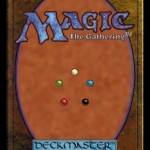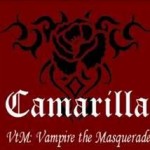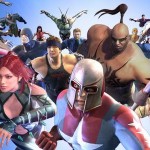In my articles about my past with the Camarilla, I have talked about how being on the board of directors led directly to my working for Wizards of the Coast. So I think now is the time to start going over some of my history with WotC.
Since this month is the 20th anniversary of the release of Magic: the Gathering, I thought I would cover some Magic history. This month has five weekends, so I am going to relate stories about five conventions I attended for WotC during the first year of Magic: the Gathering’s release
First off I would like to talk about the events surrounding my attending Gen Con in 1993, which was the debut of Magic: the Gathering to the gaming world.
I met Peter Adkison, President of WotC, at Courageous/Necrocon, and he invited me, along with the other board members of the Camarilla, to attend the WotC weekly staff meetings/ brainstorming sessions. Several of us took him up on the offer originally, but I was the only one to attend regularly. This was largely due to the fact that at the time I was newly unemployed.
Back then, WotC was very different from what people picture today. In early 1993 it was a small gaming company that was run out of the bottom floor of Pete’s house, and his garage acted as the warehouse. WotC had two product lines then; Talislanta, which was licensed from the original creators, and the Primal Order, which was an original creation of Pete’s. At the time I started showing up, the company had just settled a lawsuit that had threatened to shut them down.
Due to my consistent attendance I started getting included on a lot of things. I had a chance to pitch an idea for a supplementary product for Talislanta that came very close to being made, and I helped man the WotC table at some local conventions. So I was certainly seen as part of the gang, even though I was not an employee. But I was hardly the only one. There were also Kyle and Steve, who, like me, were part of the group but not employees.
Of course there was something else going on at the time that I’m sure everyone is waiting for me to touch on – Magic: the Gathering.
I’m going to work on the assumption that anyone reading this knows what Magic is, so I will not go into explaining that. What is worth talking about is what was going on at WotC surrounding it. At the time I showed up Magic was well into development. Art had been created, cards laid out, and a printer engaged to make it. At the time, Magic was actually being produced by a secondary company, Garfield Games, to protect it in case WotC lost that lawsuit. Garfield Games would later be merged into WotC. Around the office, the game was being played with mocked-up cards. I first learned to play the game from Pete himself. There was a lot of excitement about the game around the office. Magic was previewed at Origins during July of 1993. This is also why you will hear people refer to it being released at Origins – it was the first time people had a chance to see it on any kind of mass level.
And this leads us to Gen Con. At the time Gen Con was to the gaming industry what San Diego Comic Con was to the comics industry. WotC had a table at Gen Con and it was going to be the big debut of Magic. Gen Con that year was August 19th through the 21st, and Magic was scheduled to release on August 5th. The plan was that Pete would drive to Milwaukee where Gen Con was held and along the way stop off at various game stores to demo Magic. Everyone else would fly to Milwaukee and meet him there. Due to some timing issues with the printer, Cartamundi, who were located in Belgium, the product needed for the convention was to be drop shipped directly to the convention hall.
At the time I was not going to Gen Con with the company. I was the newest guy around the office, and tickets had been purchased before anyone had a chance to get to know me. I was fine with this of course.
That changed about a week before Gen Con. I showed up to the office to help out with packing and prep for the trip. Pete pulled me aside, and told me that one of the people who was going to Gen Con had to pull out at the last minute. He wanted to know if I was interested in taking his place. Being unemployed, it was not like I had any reason not to go, so I of course said yes. Being the early nineties we did not make any arrangements with the airline; I was just going to use the ticket that was in the other guy’s name. Looking back, it seems so surreal that we got away with that.
So we had a small group that was going to Gen Con. I can’t remember everyone that went, but I know for sure we had Pete and his wife Cathleen, VP Lisa Stevens, Art Director Jesper Myrfors, Head Editor Beverly Marshal Saling, her husband Rick, Dave Howell, who did the card layouts, Richard Garfield, and several of his college friends who ultimately formed the Magic R&D department, Steve, Kyle and myself.
Even though I was in my mid-twenties this was the first time I ever traveled on an airplane. Some of my fellow travelers made sure I had a proper send off, and by “proper” I mean “did everything in their power to make me nervous.” Their failure was the first sign that I was not a nervous flyer, unlike other members of our team who were more angry at them than I was.
Once in Milwaukee we had a little time to settle into our hotel before we had to get over to the Mecca Convention center to set up our booth for the next day. Due to budget issues, we only had three rooms (if I recall correctly), so we engaged in the time-honored convention tradition of room-stuffing. I got very lucky that first night, as Richard and his crew did not show up until the next day, so I got to sleep in a bed that night.
I remember being impressed with the Mecca Arena where Gen Con was held. At the time, it was the biggest convention I had ever attended and Gen Con used it to the full 12,700 person capacity. This was a year prior to my attending my first San Diego Comic Con where I learned what a really big convention looked like.
As we were a very small company, we were off in a section of the hall that was populated by other small publishers and specialty merchandise vendors. I can’t remember all of the companies around us, but I do remember that the company directly across from us was Inner City Games Designs, and they were showcasing their game Fuzzy Heroes, a miniatures combat game that used stuffed animals and action figures. We were roughly in the center of our row. This detail will be significant later.
It was at set-up time the day before the convention that our first problem came to light. The drop shipment of Magic cards from Belgium was short, and by short I mean it was only 10% of what we were expecting. As this was a four-day convention, we clearly would be painfully short of enough product to make any impact. We had plenty of the other games that Wizards produced, but that was not what we wanted to push. While the rest of us set up the booth, the higher-ups had some stressful phone calls with Cartamundi and the shipping company. It was determined that the shipment had been separated, and the shipping company had to work to find the rest of it. As a result, it was decided that we had to limit the amount of Magic cards any one person could buy. The limit was one deck and two booster packs per purchase. This would turn out to be a very good thing as the convention wore on.
Somewhere during all this Pete finally arrived from his road trip. He was tired, but energized by the response the game had received turning the store visits.
The next day the convention started. While we were setting up for the day we learned that the rest of our card shipment had been located and would be delivered to the convention hall in time for the second day of the convention. With that bit of stress out of the way, the day started.
At first things were slow. After all, we were a very small company off to the side of the hall. But there was a plan. We had learned from previews and the tour was that the one thing that would attract people’s attention was seeing the game being played. The combination of the unique game play and the eye-catching art would draw people in. To that end, part of our strategy was to have a couple of us go up to the open play area and just play Magic, and be ready to answer questions about it, including being able to direct people to our booth. This was a simple and very effective plan. By about lunch time we started to see some traffic as people were seeking us out to find the game. This traffic slowly increased as the day went on. It was a simple progression really. People would buy cards, they would go somewhere to open the packs to see what they got, and play a bit. Other people would see them do this and ask what they had, thus bringing in more people. Our initial plan had a viral factor. Of course the original people would come back to buy as we were only applying the limits to that purchase, as long as they did not hang around the booth. Towards the end of the day, we had a steady stream of people and were sold out of the stock we had on hand.
There was some nervousness as we had not yet received the rest of the cards, but we decided to trust that the information we had received was accurate about the shipment.
With the first day done, it was decided that we were going out to celebrate having survived. This took us to what still stands as the most interesting bar/restaurant I have ever been to; the Safe House. I would go into detail describing it, but it would take its own article, so we will save that for another day. Just know that we ended up there a couple of times.
The next day we got to the convention center and were happy to find that the rest of the cards had arrived. A decision was made to continue with the rationing of cards, but to up it to two decks and four booster packs. This was based on the increased popularity towards the end of the previous day. This turned out to be a wise decision, as even with the rationing we did eventually sell out, but had product available the entire convention.
And we knew this was true once the doors to the hall were opened. While we were out at the bar, the convention rolled on, specifically the gaming area. People who had bought cards the previous day had spent the night playing and trading cards. These had gotten even more attention from people around them. So when the hall opened, a crowd of people made a beeline for our booth. At first it was in waves. The folks who had gotten into Magic would come, buy cards and go off to see what they had gotten, build new decks, and try them out. This would lead to even more people seeing the game, coming down and buying it, thus increasing the exposure. By Mid-day Friday we determined that we did not need our people going to the gaming area to promote the game. Instead, we needed people at the booth so that others could take breaks. This was necessary as those waves of purchases became more frequent, and eventually we just had a steady stream of people lining up to buy Magic.
This led to some other interesting developments that I doubt anyone could have really foreseen. The first was the effect this had on the booths around us. For the booths to the right of us, I suppose it was ok. The line for our booth stretched all the way down the aisle, so people waiting to buy Magic cards would have a chance to check out their stuff. As for the booths to the left of us and across from us I think they were less pleased, as the moment people had their Magic cards they would run off and thus not check out those booth’s stuff.
The length of line in our section started to attract attention as people wanted to know what was going on and what all the fuss was about. From this, we started getting attention from the gaming magazines and other publishers. One publisher, Darwin Bromley of Mayfair Games, spent a lot of time around the booth. I think he did know some of the WotC higher ups, but mostly he was fascinated by Magic. Mayfair would later product one of the first non-WotC trading card games, an adaptation of SimCity.
A problem we ran into was the fact that we did not have a cash register, but instead just a cashbox, a calculator, and receipt books. This is fine if you have slow sales or even steady sales. It is not as good if you have product flying off the shelf as we did. Beverly was most often in charge of said cashbox and receipts. She was so busy that on day three she got a split on her index finger. Being the smart asses we were, the advice she got from Cathleen was, “Don’t bleed on the money.”
It was clear by the third day that we had a hit on our hands, the convention itself helped prove that. As Gen Con is a gaming convention, it has a lot of tournaments going on. One thing the convention provided for these were coupons for five dollars that could be used at any booth. At the end of the weekend the vendors would be able to redeem those coupons for cash from the convention. When Lisa went to redeem ours, she was asked how many booths she was redeeming for. When she said just ours, she was told our stack of coupons was three times the size of any other booth’s.
On day three Peter took me out to grab some lunch. Peter told me that it was clear that Magic was going to be huge and he knew that there was going to be more work around the office. Based on my being around and helping, and my performance during the convention, he wanted to hire me to work in the office. I of course accepted. A little later he had the same conversation with Kyle. I suspect Steve also got hired at the Convention, but I was not able to confirm this; but since by the following week we were all working at the WotC office full time, I figure he probably did.
One highlight of the convention worth bringing up is that we held the first ever Magic: The Gathering tournament there. Unlike the high stakes tournaments that exist now, this was a low-key affair played with decks the players had just constructed that weekend. The winner was a guy named Alex Parrish, who won a box of booster packs, a t-shirt, and a plaque. The amusing story here is that during the final match, there were people writing down the play-by-play so that we could publish it later. Unfortunately, one of those people was Kyle, who does not have the best hand writing in the world. Weeks later Steve and I were going over the notes to get it written down, and we were trying to decipher what Kyle wrote. On one play we both agreed that what Kyle wrote looked like it said, “Bong water propane”. Kyle later corrected us that it was “Bog Wraith Played.”
So the convention was a huge success for us. The industry started talking about this new game that had captured everyone’s interest, and I had a new job.
Next week we will cover the next convention I attended for the company, and what happens when an entire crew tries to share one room.



